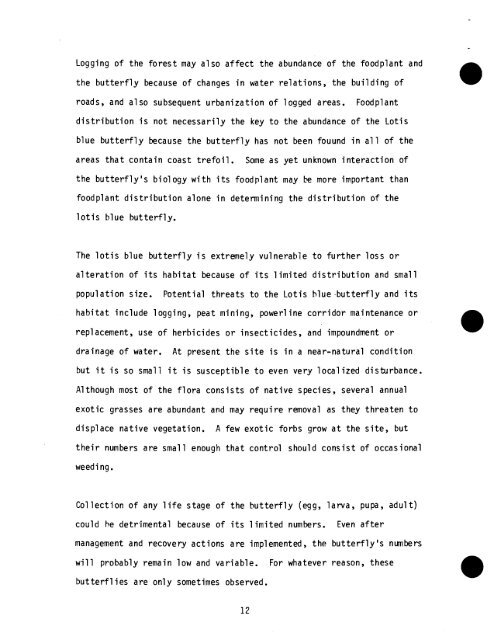Lotis Blue Butterfly Recovery Plan - U.S. Fish and Wildlife Service
Lotis Blue Butterfly Recovery Plan - U.S. Fish and Wildlife Service
Lotis Blue Butterfly Recovery Plan - U.S. Fish and Wildlife Service
Create successful ePaper yourself
Turn your PDF publications into a flip-book with our unique Google optimized e-Paper software.
Logging of the forest may also affect the abundance of the foodplant <strong>and</strong><br />
the butterfly because of changes in water relations, the building of<br />
roads, <strong>and</strong> a1 so subsequent urbanization of 1 ogged areas. Foodplant<br />
distribution is not necessarily the key to the abundance of the <strong>Lotis</strong><br />
blue butterfly because the butterfly has not been fouund in a1 1 of the<br />
areas that contain coast trefoil. Some as yet unknown interaction of<br />
the butterfly's biology with its foodplant may k more important than<br />
food plant distribution alone in determining the distri bl~ti0n of the<br />
1 otis blue butterfly.<br />
The lotis blue butterfly is extremely vulnerable to further loss or<br />
a1 teration of its habitat because of its 1 imited distribution <strong>and</strong> small<br />
population size. Potential threats to the <strong>Lotis</strong> hlue -butterfly <strong>and</strong> its<br />
habitat include 1 ogging, peat mining, power1 ine corridor maintenance or<br />
rep1 acement, use of herbicides or insecticides, <strong>and</strong> impoundment or<br />
drainage of water. At present the site is in a near-natural condition<br />
but it is so small it is susceptible to even very localized disturbance.<br />
A1 though most of the flora consists of native species, several annual<br />
exotic grasses are abundant <strong>and</strong> may require removal as they threaten to<br />
displace native vegetation. A few exotic forbs grow at the site, but<br />
their numbers are small enough that control should consist of occasional<br />
weedi ng .<br />
Collection of any life stage of the butterfly (egg, larva, pupa, adult)<br />
could he detrimental becal~se of its 1 imited numbers. Even after<br />
management <strong>and</strong> recovery act ions are imp1 emented , the butterfly's numbers<br />
will probably remain low <strong>and</strong> variable. For whatever reason, these<br />
but terfl ies are only sometimes observed.

















